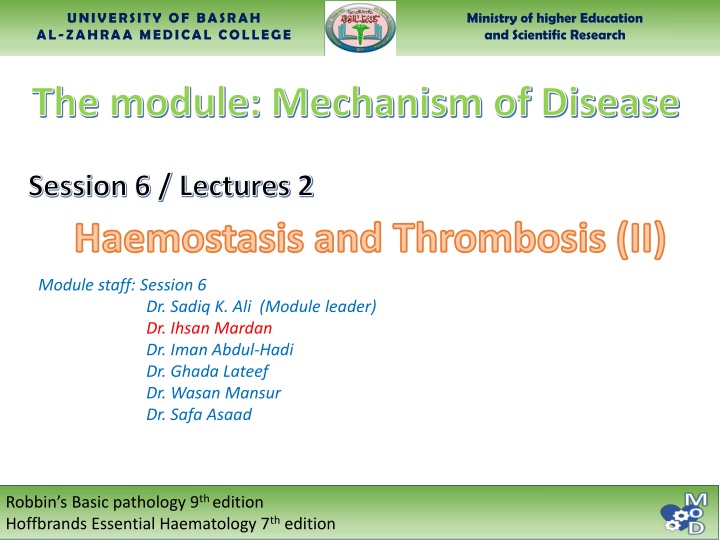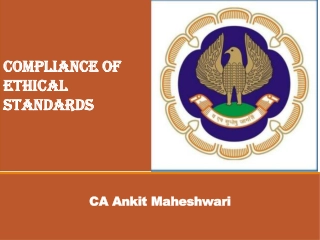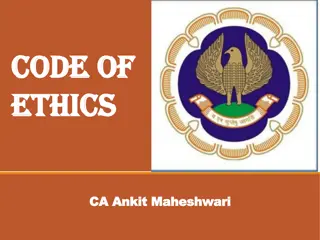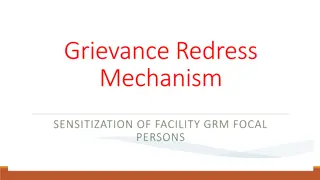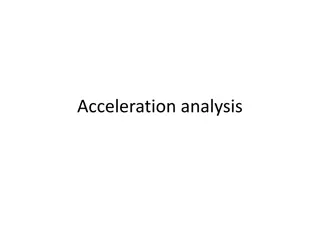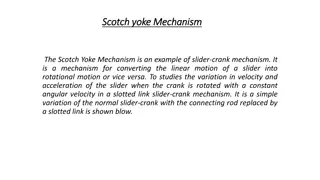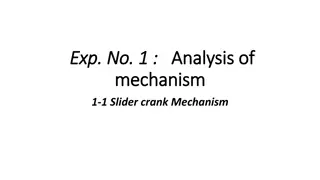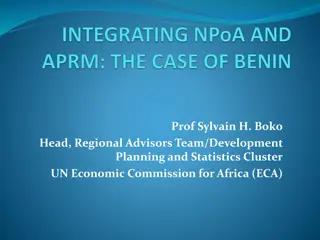The module: Mechanism of Disease
Mechanisms of heparin and warfarin in anti-coagulant therapy for disorders like DVT, pulmonary embolism, and more. Learn about monitoring techniques and recommended INR values for effective treatment.
Download Presentation

Please find below an Image/Link to download the presentation.
The content on the website is provided AS IS for your information and personal use only. It may not be sold, licensed, or shared on other websites without obtaining consent from the author.If you encounter any issues during the download, it is possible that the publisher has removed the file from their server.
You are allowed to download the files provided on this website for personal or commercial use, subject to the condition that they are used lawfully. All files are the property of their respective owners.
The content on the website is provided AS IS for your information and personal use only. It may not be sold, licensed, or shared on other websites without obtaining consent from the author.
E N D
Presentation Transcript
UNIVERSITY OF BASRAH AL-ZAHRAA MEDICAL COLLEGE Ministry of higher Education and Scientific Research The module: Mechanism of Disease Session 6 / Lectures 2 Haemostasis and Thrombosis (II) Module staff: Session 6 Dr. Sadiq K. Ali (Module leader) Dr. Ihsan Mardan Dr. Iman Abdul-Hadi Dr. Ghada Lateef Dr. Wasan Mansur Dr. Safa Asaad Robbin s Basic pathology 9th edition Hoffbrands Essential Haematology 7thedition
Learning objectives: 3. Embolism; Definition Thromboembolism particularly DVT and pulmonary embolism Other types of embolism 4. Anti-coagulant therapy; Heparin Warfarin Prophylaxis in general 5. Other disorders of coagulation; Haemophilia Disseminated intravascular coagulation Thrombocytopenia Thrombophilia
Session 6 Lecture 2 LO:4 4- ANTI-COAGULANT THERAPY Heparin: Heparin is a glycosaminoglycan carbohydrate that contains variable repeats of a disaccharide unit. It indirectly inhibits the serine protease coagulation factors by enhancing the action of antithrombin Preparations are either unfractionated UFH(standard heparin) or fractionated (low molecular weight heparin [LMWH])e.g. dalteparin, enoxaparin. LMWH are better able to inhibit factor Xa than thrombin
LO:4 4- ANTI-COAGULANT THERAPY Heparin: Heparins are only active when administered parenterally. The APTT is used for routine monitoring of therapeutic doses of UFH Falls in platelet count (>50% compared with baseline) after 5 days of treatment should raise the possibility of heparin-induced thrombocytopenia (HIT) Fondaparinux, a synthetic analog of the heparin, is an indirect factor Xa inhibitor. Given subcutaneously with a half life of 17 hours, it does not require laboratory monitoring.
LO:4 4- ANTI-COAGULANT THERAPY Warfarin: Warfarin is vitamin K antagonist, that inhibit synthesis of normal FII, FVII, FIX and FX and so result in anticoagulation. Vitamin K is needed for the post-translational modification of the vitamin-K-dependent factors (II, VII, IX, X, protein C and protein S). The anticoagulant effect varies between individuals and over time and needs to be monitored by the International Normalized Ratio (INR).
LO:4 WARFARIN THERAPY: RECOMMENDED RANGES FOR INTERNATIONAL NORMALIZED RATIO FOR DIFFERENT CLINICAL INDICATIONS
LO:4 4- ANTI-COAGULANT THERAPY Warfarin: cont After warfarin is given, factor VII levels fall considerably within 24 hours but prothrombin has a longer plasma half life and only falls to 50% of normal at 3 days; so if immediate anticoagulation is needed, heparin is given initially.
LO:4 4- ANTI-COAGULANT THERAPY Prophylaxis in general: The decision as to whether to continue anticoagulant treatment indefinitely after a first proximal DVT or PE is dependent on the risk of recurrence without continued treatment and the perceived risk of bleeding on anticoagulation. Long-term anticoagulation is usually given after recurrent unprovoked VTE. For patients who receive long-term anticoagulation the risk benefit ratio of continued treatment should be reassessed at regular intervals.
LO:4 4- ANTI-COAGULANT THERAPY Prophylaxis in general: cont Following an episode of venous thrombosis, patients are 40 times more likely to suffer an event in the future than patients who have not previously suffered from venous thrombosis. Patients with VTE provoked by surgery have an annualized recurrence rate of <1%. Patients with VTE provoked by a non-surgical factor have an annualized risk of 4% and patients with unprovoked VTE have an annualized event rate of 7%.
LO:4 Suggested duration of anticoagulation
LO:5 5- Other disorders of coagulation Haemophilia: Haemophilia A (factor VIII deficiency): It is the most common of the hereditary clotting factor deficiencies. Haemophilia B (Christmas disease, factor IX deficiency): The incidence is one fifth that of haemophilia A. The inheritance is sex linked but up to one third of patients have no family history and these cases result from recent mutation.
LO:5 Haemophilia A: clinical severity
LO:5 5- Other disorders of coagulation Haemophilia: cont The characteristic bleeding pattern of haemophilia, which is both delayed after trauma and much prolonged. Replacement by intravenous infusion of the deficient factor can normalize the haemostatic mechanism. Recurrent haematomas dominate the clinical course of severely affected patients and, if inadequately treated, lead to progressive joint deformity and disability painful haemarthroses and muscle
LO:5 Haemophilia A showing severe disability of the left Knee
LO:5 5- Other disorders of coagulation Disseminated intravascular coagulation: Widespread inappropriate intravascular deposition of fibrin with consumption of coagulation factors and platelets occurs as a consequence of many disorders that release procoagulant material into the circulation or cause widespread endothelial damage or platelet aggregation.
LO:5 5- Other disorders of coagulation Disseminated intravascular coagulation: cont It may be associated with a fulminant haemorrhagic or thrombotic syndrome with organ dysfunction or run a less severe and more chronic course. The main clinical presentation is with bleeding but 5 10% of patients manifest thrombotic lesions.
LO:5 Disseminated intravascular coagulation: cont The key event underlying DIC is increased activity of thrombin in the circulation that overwhelms its normal rate of removal by natural anticoagulants. The pathogenesis of disseminated intravascular coagulation and the changes in clotting factors, platelets and fibrin degradation products (FDPs) that occur in this syndrome
LO:5 5- Other disorders of coagulation Thrombocytopenia: Thrombocytopenia defines a subnormal number of platelets in the circulating blood. It has a wide range of causes including: (i) failure of platelet production from a congenital cause, drugs or viral infection or a general bone marrow failure; (ii) increased consumption of platelets. This may be acute or chronic autoimmune, drug induced, caused by disseminated intravascular coagulation or thrombotic thrombocytopenic purpura.
LO:5 5- Other disorders of coagulation Thrombophilia: There is no internationally accepted definition of thrombophilia. The term is sometimes used to describe disorders of haemostasis detected in the laboratory that appear to predispose to venous thrombosis. A clinical definition of heritable thrombophilia describes an inherited tendency for venous thrombosis, i.e. deep vein thrombosis (DVT) with or without associated pulmonary embolus (PE).
LO:5 5- Other disorders of coagulation Thrombophilia: cont Prevalence of heritable thrombophilias shown to be associated with at least a two fold increased risk of venous thrombosis in patients and controls
